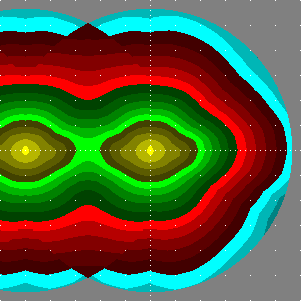


|

|
| In the left half of the left plot, specific illuminance by a continuous row of luminaires spaced 5 heights is shown (right half is for a single luminaire). | The right plot is for a single luminaire, unrotated. |

Values below the scale are illuminance / 1 lx. This is for (unrealistic) “unit” case that luminaires would have lamps producing 1 klm only, would be point-like and just 1 m over the terrain.
# [MANUFAC] .hess
# [TEST] 9088
# [LUMINAIRE] TORONTO
# [LUMCAT] 10.04631.7200
# [DATE] 16.02.04/10.04.1997/fg |16.02.04 LUMCat
# down given: 100%
# out given: 78.5%
# tilt: 0.0
# [LAMP] HSE-E 70W
# Source file: ldt/TOR9088A.LDT
# Luminaire flux = 752 raw, for the given bulb(s) it would be 8417 lm,
# 75.2 % of the bulb flux
# between 75 and 90: 0.0 % of the luminaire flux
# - this part causes just GLARE in case of road lighting and similar purposes
# 80deg and above: max 48.4 cd / 1000 lm , 0.2 % of the luminaire flux
# 90deg and above: max 0.9?cd / 1000 lm , 0.0?% of the luminaire flux
# CutOff Type: IES_CutOff
# Increase of Sky Luminance due to light going
# from the luminaire difectly above horizon, as compared with the
# luminance produced by the light dispersed from the ground: 0?%
# Increase of Sky Luminance in Distant Places by light below 15.0 degrees
# due to light going from the luminaire directly above horizon: 0?%
# (for the zenith luminance such an angle suits places up to 19 km distance)
# The increases concern the following situation:
# Albedo = 0.10
# Zenith Extinction = 0.30 mag (i.e., direct light remaining 76 %)
# Indicatrix type =0 (0: acc. to P.Cinzano, 4..6: CIE sky types)
# (the downward-scattered part of lambertian uplight is 0.1108 then)
# 62.5 deg to <67.5 deg: max -99 cd / 1000 lm,
# 67.5 deg to < 76 deg: max 220 cd / 1000 lm,
# maximum spec. lum. intensity 346 cd / 1000 lm
# The following table gives luminous intensities which would be produced
# using a hypothetic bulb giving a luminous flux of 1000 lm (i.e., cd/klm):
# H: 0.0 10.0 20.0 30.0 40.0 50.0 60.0 70.0 80.0 90.0 100.0 110.0 120.0 130.0 140.0 150.0 160.0 170.0 180.0
#V:
0.0 223 223 223 223 223 223 223 223 223 223 223 223 223 223 223 223 223 223 223
10.0 209 209 207 204 200 198 197 198 198 200 200 201 202 203 205 208 210 210 210
20.0 176 177 178 177 176 179 182 186 189 192 192 191 189 187 186 186 187 185 185
30.0 148 150 153 158 164 171 179 185 191 196 196 193 188 182 176 171 167 164 163
40.0 132 133 139 149 162 177 187 191 203 219 221 209 192 182 171 162 154 153 153
50.0 118 124 132 137 140 158 171 204 260 303 299 255 206 178 159 149 145 140 137
60.0 90.9 95.3 99.7 104 105 112 133 206 306 346 306 238 170 133 123 119 117 113 109
70.0 66.5 68.7 72.6 77.0 74.6 72.6 91.0 137 196 220 182 125 85.5 83.2 94.3 100 98.0 92.0 83.5
80.0 29.0 33.5 33.0 30.2 25.9 23.9 27.2 31.8 45.7 48.4 41.6 18.9 18.5 26.3 27.3 32.1 37.7 37.7 28.3
90.0 0.6 0.7 0.7 0.7 0.7 0.8 0.8 0.8 0.9 0.9 0.8 0.8 0.8 0.7 0.7 0.6 0.6 0.6 0.6